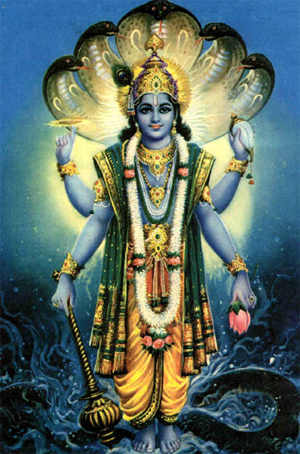|
The idol of Lord Vishnu or his incarnation always has the Image of his consort Goddess Laxmi. The serpent Ananta- Shesha’s hood serves as a parasol above them. In front of the shrine stands the Dhvaja, eagle-banner of the Lord.

Shalagrama
The legend goes that the Gods could not defeat the demon Shankhachuda because of the chasity of his Vrinda which protected him from any harm.Vishnu came to the resecue,
he transformed himself into Shankchuda and entered her chamber and tricked her as she could not recognize the imposter. Thus soiling her virtue which led to the death of her husband as he was no longer protected by the power of her chasity. When Vrinda discovered how she was tricked she flew into a rage and cursed Vishnu and turned him into a stone.
Thus the Shalagrama stone is sometimes worshipped instead of Vishnu.
Tulsi
Vrinda the destitute wife of Shankhachuda was shunned by all, she reached the doors of Vaikuntha the abode of Lord Visnu, but Lakshmi refused to let her inside the gate. Tulsi stood in the courtyard of Vishnu’s abode under the open sky extremely hurt, humiliated and helpless. Her feet turned into roots and her arms sprouted leaves she soon turned into a delicate wild plant her fragrance spread all around.
Lord Vishnu came out and announced that ‘BY NOT ABONDONING HER DEVOTION TO ME’ even when faced by extreme cicumstances Tulsi has become my beloved, Vishnu Priya. Therefore she must be treated with dignity at all times, not as an unchaste woman but like a venerable housewife
Sumangali.
From that day onwards she was worshipped in every household, This basil, Ocymum santcum is a fragnant medicinal plant. No pooja of Vishnu is complete without Tulsi leaves. Tulsi beads are also used as rosaries while chanting the ame of the Lord.
On Ekadashi the eleventh day of thebright and dark halves of the lunar month. Devotees chant his name keep a fast, visit temples, bathe in holy waters and perform charitable deeds.
Sacred Symbols
Legend goes that Savitri the consort of Lord Bhrama was late for a yagna. Vishnu created Gayatri to assist Bhrema with the rituals. On arriving there and seeing Gayatri, Goddess Savitri flew into a rage and cursed Vishnu “Your foot prints will be more venerable than your body” Therefore even today the foot prints of Vishnu or ‘Vishnu Pada are considered very auspious.
Sacred symbols of Vishnu inclue Lord Vishnu’s conch and disc, lotus, fish,lion, makara, turtle and go-pada (the foot prints of cows) Another symbol is related to his consort Laxmi, this is the swastik which means su- asti which means arrival of all good things.
These symbols are often painted on the floor and walls of new houses and offices to ensure thegrace of the lord and to ward off malevolent spirits.
The Vishnu- Padas are usually drawn pointing towardsbthe house to symbolize the arrival of divine grace.
Sacred Marks
The Urdhva-pundra or Namam is painted on the forehead of Vaishnavas using sandlwood paste or white clay. Two lines are drawn meeting at the base, these represent Vishnu Pada
or footprint of Vishnu. Between these two lines is a red dot this represents Vishnu’s active energy his shakti his consort Shree Lakshmi.
Sacred Observances
Some practises are observed to enhance the personal relationship between Vishnu and his true devotees these are:-
Shravanam:- is hearing about the Lord through sacred texts and lectures.
Vandanam:- praising the Lord through songs, bhajans & kirtan. The hymns can be in Sanskrit or vernacular languages.
Smaranam:- remembering the Lord by chanting
Mahapuja (SatyaNarayana)
This is a great ritual adoration of the supreme Lord performed by priest’s invited by devotees to perform the pooja in their homes. The image of Lord is placed on a pedestal.Flowers and fruits are offered along withTulsi sprigs, The 108 names of Vishnu are chanted along with the katha. |

